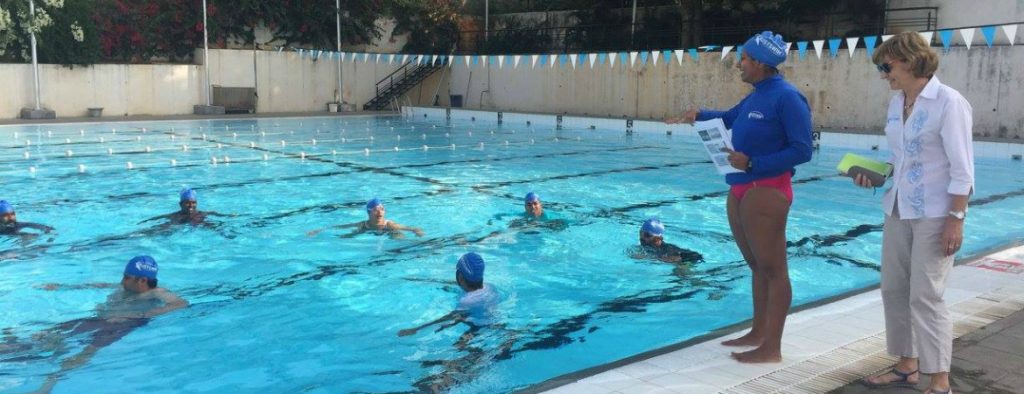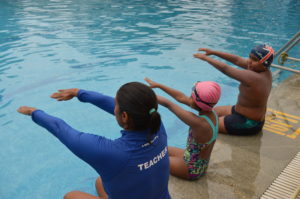
What does one mean by aquatic education?
A conversation with Ceri Weeks, the award-winning AUSTSWIM Presenter (Trainer of swim teachers), got me asking this. By education, we mean books right? And isn’t aquatic merely another word for swimming? Turns out there is much more to this concept than this simplistic point of view. And this is exactly where AUSTSWIM steps in.
AUSTSWIM is the Australasian council for the teaching of swimming and water safety. AUSTSWIM has developed quality aquatic education programs for those wishing to enter the aquatic industry as a teacher of swimming and water safety. The AUSTSWIM license is internationally recognized as the industry standard for swimming and water safety teachers and is delivered and recognized in each state and territory of Australia and many countries overseas. One can find this introduction to AUSTSWIM on their website which is pretty self-explanatory. However, it was how Ceri described it as being a one-stop place for all kinds of information swim teachers would need for teaching swimming and water safety, is what got me hooked.
When you are looking to learn swimming or you want your child to learn swimming, what do you do? Go to a local swim club and have yourself enrolled in one of their batches. You rely on their knowledge, their expertise, and their education of the subject to learn this subject yourself. However, what if your teacher never got the complete information on what makes for a right swimming environment? You learn what he passes on to you and thus continues the chain of passing on ideas and thoughts around aquatics according to the convenience and experience of different people.

According to Ceri, this was the whole idea around which AUSTSWIM started in the first place. The aim was to have a standard, a uniformity, a consistency in the knowledge passed from one learner to another. To create a knowledge bank, which can be relied upon to have one’s fundamentals right. As Ceri puts it, think of this as the learning one gets in their school years as against the learning one is exposed to in a University. The job of a school teacher is to ensure the student’s foundation is strong and stable so that when that student reaches University, he or she is ready to take on new forms of learning.
This analogy made me stop and think. Could this be a reason why we are unable to get the desired results at the top of the pyramid, because our basics aren’t right? On asking this aloud, Ceri had a very interesting perspective on swimming in India. Swimming here is measured more in terms of quantity than quality. Our aim seems to be always on being fast, which is fair, but the focus on fast is at the wrong time. According to Ceri, any child who is exposed to swimming starting from six months to even four years, should only be focusing on the fundamentals. The child should be exposed to all kinds of aquatic environments- oceans, rivers, etc.- and not just the swimming pool. A child who is comfortable in all such environments and who has had enough time to get their basics right, would be ready to further himself or herself in terms of competitive swimming learning.
In order to get to this stage, Ceri has been travelling to India over the last three years several times, working closely with Swimming Matters – India, part of Winning Matters Consulting, to establish a healthy network of teachers who can in turn create a rich foundation of swimmers. She has so far trained over a 100 swim teachers during this period and has also been pivotal in training the only two fully-qualified AUSTSWIM-certified trainers in India – Olympian swimmer Nisha Millet Chatterjee and Partha Varanashi.
A typical AUSTSWIM course covers the basics to understand water safety and a healthy swimming environment for the teachers, however, there are extension courses which go deeper such as courses on for Infants and Pre-school Aquatics, Adults, Access and Inclusion (includes working with Differently-abled) and Competitive strokes which also give AUSTSWIM teachers the scope to delve deeper into their area of choice. Each course of AUSTSWIM has a manual, which is further divided into modules, and each of these modules have been developed through the assistance of coaches and industry experts such that every participant can be rest assured that the AUSTSWIM-qualified teachers are meeting the highest standards to foster safe aquatic learning environment.
And finally, my last question to Ceri was, AUSTSWIM has been active in Australia for over 37 years now so how have the results been like over there? She needn’t have answered this question at all as the answer is pretty much out there in front of us all to see on a daily basis, isn’t it?
